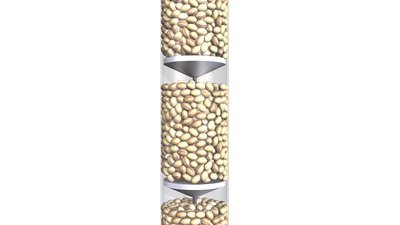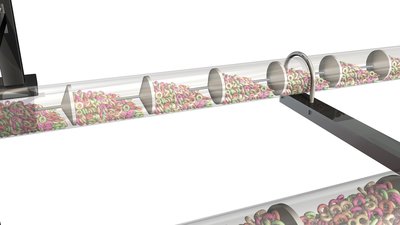Streamlining breakfast cereal processing
The latest generation of tubular drag cable conveyors provides critical process and product quality benefits for breakfast cereal processors. Minimised product damage, improved product safety, reduced clean-up and faster changeovers are key advantages over traditional conveying systems.
Whatever the food item - from frozen pizzas to fresh burritos, baked goods to candy, health bars to processed cheese - the need for transporting food products through each process stage in the food production line with high throughput, minimised product damage and a high level of product safety is of critical importance.
Regardless of the quality of processing and packaging machinery, if the material handling system being used is inefficient then the finished products and throughput volume will be compromised. Yet, too many food manufacturers are plagued with conveying equipment that is not suited to the needs of their particular processing and packaging applications.
One industry that is heavily reliant on conveying systems is breakfast cereal manufacturing, where a variety of different conveyor applications have traditionally been used to transport cereal products between sequences of processes.
Critical conveying challenges in breakfast cereal production
Breakfast cereal processing plants often face several critical conveying challenges. One of the most important is ensuring that the product emerges undamaged before its final packaging. However, keeping the clusters, loops, puffs and flakes whole can be a significant challenge, given that at the end of most machine processing steps the product is dropped down onto a conveyor system before being taken to the next process. The ideal outcome is to transfer the product through the processes and into the packaging as gently as possible to avoid breakage.
Breakfast cereal plant managers and plant engineers know that the way their product is conveyed during the manufacturing process plays an important role in ensuring minimum waste.
Product contamination is another issue. In every step of the process, precluding any foreign matter from entering the process stream is a critical objective. Traditionally used in cereal processing, bucket elevators and belt conveyors not only permit the entry of cereal dust and foreign particles into the food stream, but their exposed format means they can spread dust.
This opens the door to contamination and the spread of allergens. This problem is particularly evident during product transfer between the coating, drying and packaging operations, where there is exposure to a combination of different ingredients.
Line changeovers have become a focal issue in breakfast cereal plants in terms of cleanliness and speed. Companies increasingly aim to run different product lines within a shift or day. Despite these changeovers, processing plants are expected to maintain stringent levels of sanitary operation. Cleaning conveying systems can be a time-consuming challenge.
Every minute spent disassembling a conveyor system for cleaning consumes valuable production time. Yet, if not cleaned properly, product may need to be discarded in-process because of contamination. Worse, consumers could be negatively impacted, resulting in potential injury, costly recalls and impacted brand reputation. To resolve these issues, cereal processors are charged with administering changeovers as quickly as possible while maintaining 100% system cleanliness.
Traditional systems for conveying breakfast cereal
For decades, open conveyors have been the predominant systems used to transport breakfast cereal products through the manufacturing process. But because of the limitations of these open conveying systems, cereal processors have gradually moved to other conveyor types, particularly closed-system tube conveyors. Like open conveyors, they each have design strengths and weaknesses. Below is an assessment of the major types of systems used in breakfast cereal processing:
Flat-belt conveyors
Although this type of conveyor handles cereal products gently, the product is exposed to ambient contamination unless covered. The cover, however, collects cereal residue and must be removed and cleaned between runs to reduce cross-contamination risk. When introduced onto the conveyor, the cereal product is dropped from the processing machine, which produces dust and can cause product damage.
Bucket elevators
Bucket elevators use a continuous line of buckets, either attached to each other on a rubber belt or attached by pins to two endless chains running over tracks and driven by sprockets. Centrifugal force throws the cereal out of the buckets into a discharge spout as the buckets pass. This type of conveyor can transport fragile materials with minimal product damage. However, the system can be very dusty, as dust is generated when cereal is loaded into the buckets and while the product is being conveyed. The excessive dust produced can also open the door for dust explosions.
Pneumatic conveyors
These systems use air to move cereal from extruder to packaging by generating air pressure levels that are either above or below the atmospheric pressure. Pneumatic conveyors enable flexibility, allowing products to reach multiple destinations with one system. They can also convey cereal at high rates without product breakage and with minimal dust dissemination. Pneumatic conveying is the most expensive method for moving cereals due to its high power consumption.
Auger conveyors
Known as flexible screw conveyors, auger conveyors can transport cereals vertically, horizontally and at any angle. They consist of a stainless steel flexible screw enclosed in a rigid steel tube or flexible plastic tube driven by a motor. These conveyors have a throughput of up to 45,000 kg/h. However, they are limited in how much product they can transport before effecting product breakage. Also, internal cleanliness can be an issue, with the unit having to be dissembled regularly for cleaning.
Aeromechanical conveyors
These completely enclosed, high-capacity mechanical conveyors can move breakfast cereal vertically, horizontally and at varying angles. Within a stainless steel tube, a wire rope with evenly spaced discs travels at high speeds, running in sprockets at each end of the conveyor. The high-speed action generates an internal air stream travelling at the same high velocity as the discs. As the cereal is fed in, the air stream aerates, or fluidises, it and carries it to the packaging outlet, where it is discharged by centrifugal force. The system can move up to 100,000 kg/h of cereal.
One drawback is that the flow of product can easily become inhibited, causing the conveyor to run without transporting cereal at expected throughput volumes. Downtime is also a factor because the tension on the wire rope needs to be adjusted at regular intervals.
Tubular drag chain conveyors
This conveyor gently moves breakfast cereal through a sealed tube with a drag chain pulled through it on a loop. Solid circular discs (flights) are attached to the chain, which push the cereal through the tube. This system can move up to 36,000 kg/h of cereal and can run under either pressure or vacuum modes. The chain tends to accumulate cereal debris build-up, which poses a cross-contamination risk, so it needs to be regularly removed. Also, the chain-drive components need to be regularly adjusted to keep the system in registration, which increases downtime.
Such traditional conveying systems have struggled to keep pace with the increasingly challenging requirements that breakfast cereal processors face - not to mention corporations’ continued push for more cost-efficiency and higher throughput on their processing lines, which is also driving the need for system upgrades in breakfast cereal processing worldwide.
Conveying systems installed 10-15 years ago incorporating the above systems may have been adequate at that time. But now better technology in conveying system design, controls and automation has brought in a new generation of conveyors. Safer, cleaner processes that reduce waste and deliver cost, labour and energy savings are increasingly being factored into equipment selection. Such conveying systems have critical impact on cereal processors’ operational costs and plant ROI.
Tubular drag cable conveyors - a more efficient lean-process conveying solution
The tubular drag cable conveyor, developed by Cablevey Conveyors, is fast becoming the conveying system of choice for breakfast cereal production. The system gently moves friable cereals through an enclosed tube without the use of air. This generation of tubular drag cable conveyors can transport up to 22,000 kg of breakfast cereal product per hour, at low speed and with virtually no product degradation.
Similar to tubular drag chain conveyors, tubular drag cable conveyors gently move product through a sealed tube, but instead using a patented, coated, flexible stainless steel drag cable. Solid circular discs (flights) are attached to the cable, which push the cereal through the tube. The coated cable ensures that no debris accumulates within the stands of the cable, as the cable is totally sealed.

Designed for quick cleaning, quick line changeovers and maximised system uptime, the tubular drag cable conveyor system employs cleaning mechanisms that reduce debris build-up. The completely enclosed system keeps contamination out, but can be cleaned-in-place at multiple points. For example, an air knife at the product discharge locations in the system automatically releases food particles from the discs and cable. Also, urethane wiper discs attached to the cable eliminate any residual debris from the conveyor system while in progress. The system is equipped with a cable self-tensioning device.
The tubular drag cable conveyor operates on low horsepower, using energy-efficient variable-speed motors of less than 5 HP each, consuming minimal power compared to other conveyor systems. The system’s production flow can be adjusted to variable speeds.
Versatile integration throughout all breakfast cereal production processes
This tubular drag conveyor system has the unique flexibility to integrate with any processes in cereal production. The conveyor can be integrated into all processing areas, such as: receipt, weighing and mixing of raw materials; preconditioning and extrusion; drying, tempering, flaking and toasting; and coating, drying, cooling and packaging.

Tubular drag conveyors are ideal systems for moving product between the extrusion, forming, tempering, flaking and toasting processes, and on through to the coating process.
The system is critically applicable where product can become particularly damaged, where contamination would be prevalent or where dust accumulation can be excessive, such as end-of-line processing from coating through packaging. These areas would include the coating process to the dryer, from the dryer to the weigh-filler, from the dryer to the holding silo, then from these processes to packaging.
“In the cereal production marketplace, quality and product safety are very high-profile issues,” said Gary Schliebs, Process Engineer with Plus One-Percent Engineered Solutions, engineering implementers to the food industry.
“More and more breakfast cereal processors are looking at using this tubular drag conveyor technology right from the initial mixing phase to the blender, then into an extruder. Some major manufacturers are also implementing the system even further downstream, from their extruder to their coating system and through to their packing line. Here is a system that they can go with all the way - an end-to-end package solution that fits perfectly from a cleaning perspective and from an enclosed system point of view, and the risk is absolutely minimal from a contamination or hygiene issue.”
The tubular drag conveyor truly embodies a new generation of conveying solution for breakfast cereal processors.
Irish drinks manufacturer takes its supply chain to the next level
A stainless steel vertical conveyor system has been incorporated into the final packaging process...
Voice technology used to transform cold storage operations
Dematic has implemented its Voice solution with gamified workflow features at two Australian...
Rock lobster exporter improves supply chain efficiency
Transport technology provider Microlise partners with rock lobster exporter in Western Australia...








